| Home
|
BALI
Land of temples, volcanoes, rice fields, good diving, great food and insane traffic
The Indonesian island of Bali is located about halfway down the 3,000 mile long archipelago of Indonesia in SE Asia. If you look at a map of Bali, the locals say it looks like a chicken, and it really does!
Indonesia consists of over 17,508 islands, only 6000 of which are inhabited. Spanning three time zones, there are over 240 million Indonesians, with almost 60% living on Java, the world's most populous island.
Though Indonesia is a predominately Muslim nation (88% of the population), Bali is predominantly Hindu. Hindus though make up less than 2% of Indonesia overall. Christians comprise about 10% and Buddhists less than 1%. With over 300 ethnic groups in Indonesia, there are in excess of 737 living languages. The language of Bali is Indonesian (Bahasa Indonesia). More than half of Bali's population of over 4 million live in the cities.
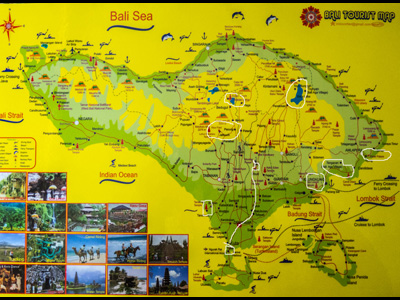 Bali Map Bali Map
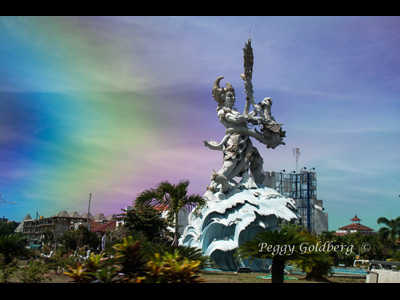 Statue Statue
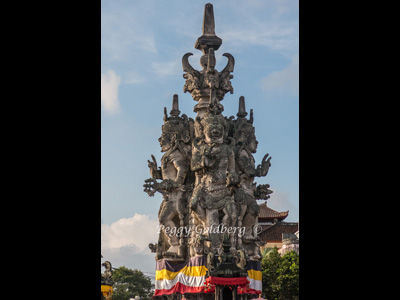 Four Sided Statue Four Sided Statue
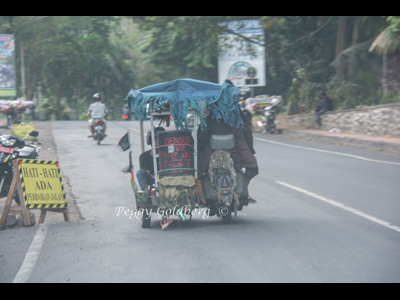 Motorbike Sidecar Motorbike Sidecar
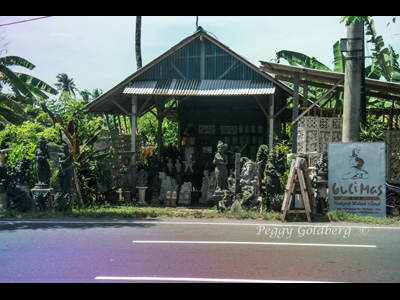 Statue Shop Statue Shop
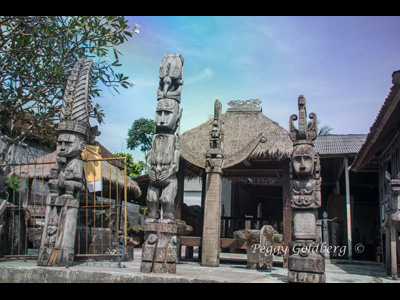 Another Statue Shop Another Statue Shop
 Penjar And Roofs Penjar And Roofs
 Funeral Funeral
 Traffic In Ceremony Traffic In Ceremony
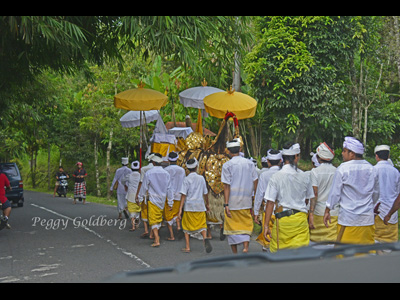 Funeral Procession Funeral Procession
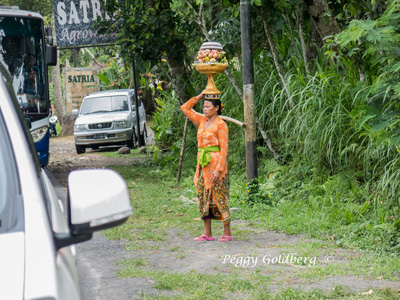 Woman Carrying Offering Woman Carrying Offering
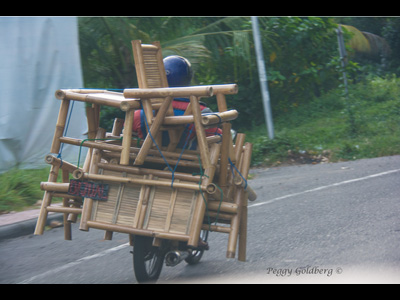 Motorbike Moving Co Motorbike Moving Co
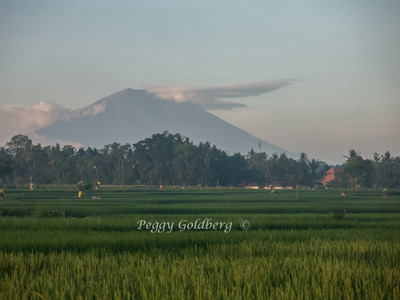 Volcano View Volcano View
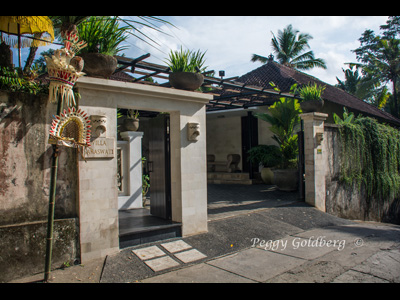 Villa Saraswati Entrance Villa Saraswati Entrance
 Villa Pool View Villa Pool View
 Payogan River by Villa Payogan River by Villa
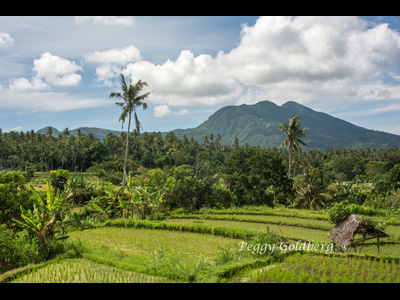 Mountains and Rice Fields Mountains and Rice Fields
 Bali Map Bali Map
After thirty six hours of travel, we finally landed near Denpasar, Bali's provincial capitol. Our final destination, the Wakatobi Dive Resort in the SE Sulawesi area of Indonesia, was 700 miles ENE of Bali. We were scheduled to dive for a couple of weeks at the resort and on the Pelagian live-aboard dive boat. This area is known for its world class diving, but we planned to spend a few days on Bali exploring the temples, rice fields, volcanoes, lakes, culture, religion, and Balinese food. We were aware that Bali also has world class diving, but we were limited by time.
We had only allotted five days on Bali to see everything, purposely avoiding all tourist areas, hotels and restaurants. We felt this time would allow lost dive gear to catch up with us and for our bodies to adjust to jet lag. As it turns out, the gear was not delayed, and we experienced no jet lag at all!
We had arranged, through the Wakatobi staff, for a guide for four full days of personal tours. They assisted us with suggestions on places to stay, away from the hustle and bustle.
They met us at the airport, gave us a cell phone so we could call home, or them, and some Rupiah to get around for a while. We arrived at 1 AM and decided to stay at an inexpensive hotel across from the airport, the Harris Tuban. It was actually very nice, and offered a Balinese Breakfast buffet. We checked out that morning heading to Ubud, to a bed and breakfast north of town. We had reserved a quiet room at the Villa Saraswati, in the village of Payogan, where we would spend the remainder of our Bali stay.
Suka, our guide, had prepared itineraries suited to our interests. Bali has many active diversions including rafting, zip lining, diving (of course), surfing, hiking and riding elephants. Not forgetting the cultural side, you can also attend yoga, cooking, cultural and language classes or visit the bird park. We did spend some time learning a little Indonesian, although English was spoken in most places.
Turning into an alley, we pulled up next to a wall with big wooden gates and a small sign announcing VILLA SARASWATI. Named after the Hindu goddess of knowledge and arts, the modest sign was the only indication that it was not a private home. The gates opened to a lovely Balinese designed, 2 story 5 bedroom Bed and Breakfast, nestled in a jungle like area by the Payogan River. (Balinese for creek). With a lovely pool, outdoor eating area, living room, media room, and suites that were spacious, Villa Saraswati was well designed and quiet. Run by an Australian couple, we felt like we were visiting their home, and they and the staff accommodated our every need. The breakfasts, and light meals were delicious, and after a long day of touring Bali, it was a welcome retreat.
Robin and Dean Emslie, owners of the Saraswati, have opened new villas on the north shore of Bali, Villas Tejakula. Located on the water, the diving is almost at your front door. Arrangements have been made with the local dive shops to make your exotic dive and snorkel vacation a reality.
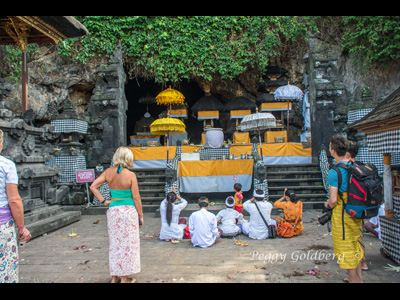 Bat Cave Temple Ceremony Bat Cave Temple Ceremony
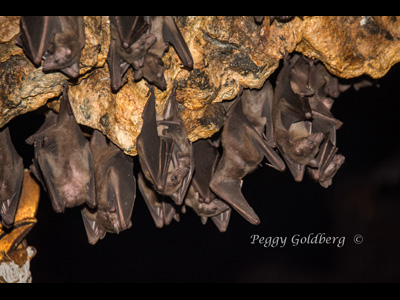 Bats Bats
 Temple roofs Temple roofs
 Beach in front of Bat Cave Temple Beach in front of Bat Cave Temple
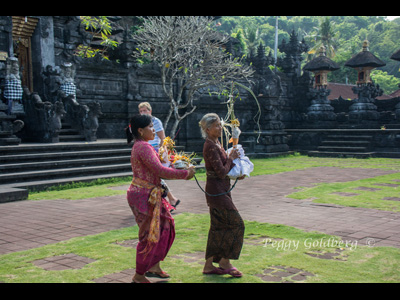 Bringing Offerings Bringing Offerings
 Locals On Water Locals On Water
 Dragon Head Dragon Head
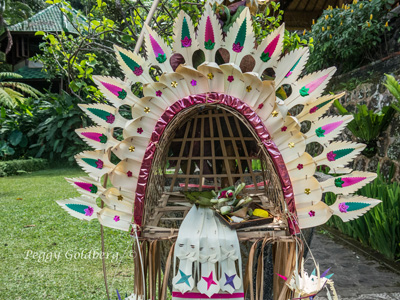 Offering Alter Offering Alter
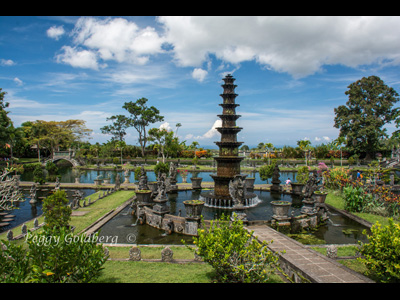 Tower Overview Tower Overview
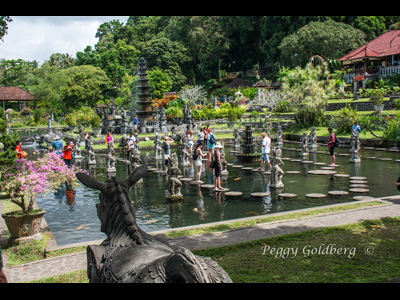 Waterpark Waterpark
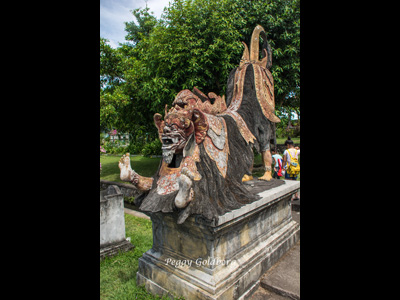 Barong Statue Barong Statue
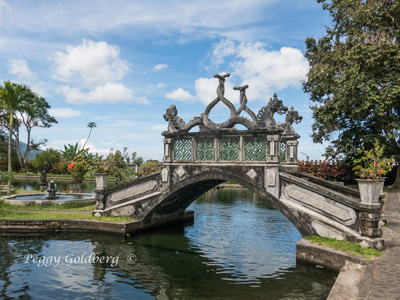 Bridge Bridge
 Hall Of Justice Hall Of Justice
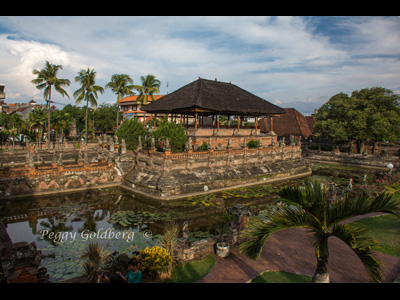 Hall Of Justice Hall Of Justice
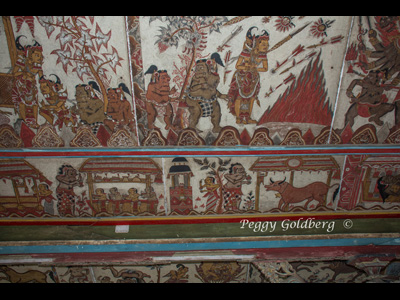 Ceiling Paintings Ceiling Paintings
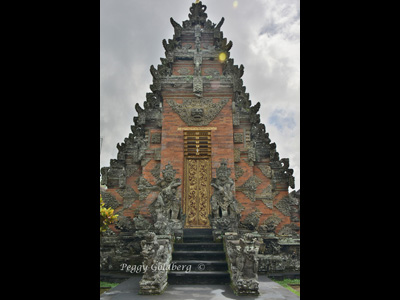 Ornate Structure Ornate Structure
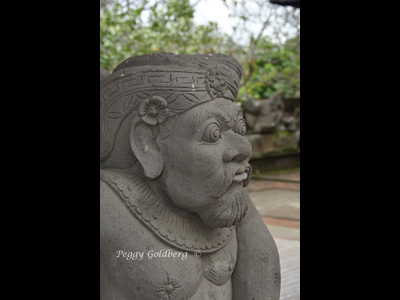 Stone Man Stone Man
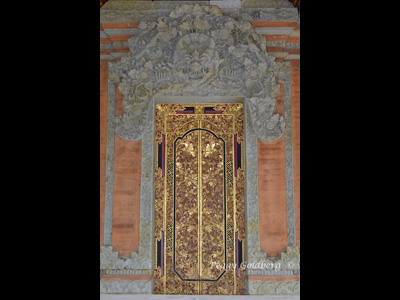 Temple Door Temple Door
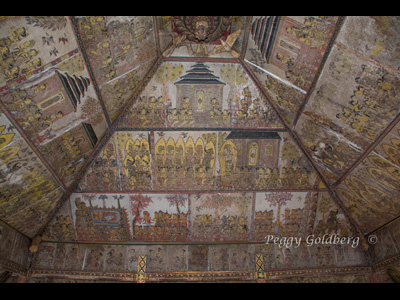 Temple Ceiling Temple Ceiling
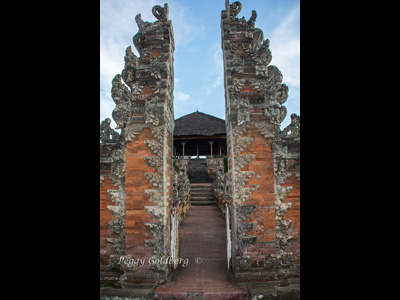 Temple Gates Temple Gates
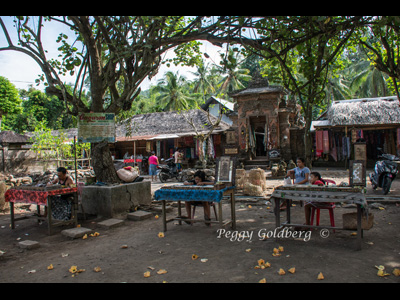 Village Ladies Selling Wares Village Ladies Selling Wares
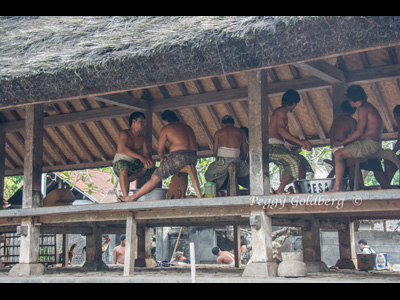 Village Men Village Men
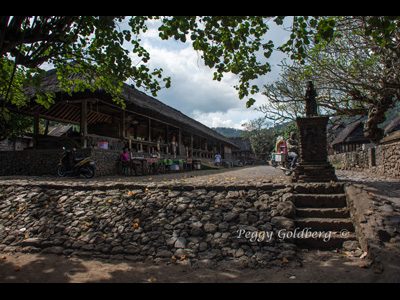 Tengenan Village Tengenan Village
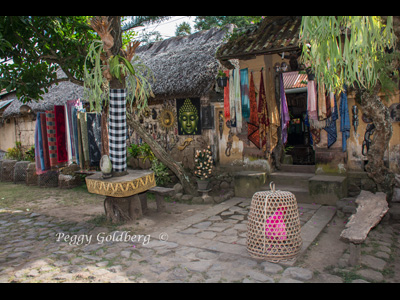 Village Shop Village Shop
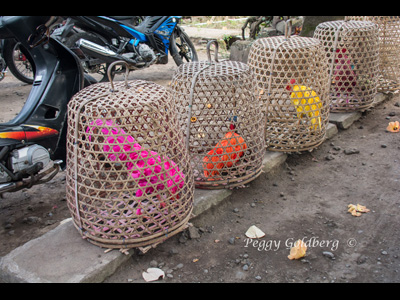 Colored Chickens Colored Chickens
 Locals On Water Locals On Water
We were warned not to rent a car and were thankful we heeded the warnings. Traffic is insane. Everyone rides motorbikes (and by everyone, I mean whole families and the dog on one bike). There seems to be no speed limits or rules of the road. Passing on both sides is the standard, on roads that could really only accommodate 1.5 vehicles, not 2. There were no signs to indicate which roads you may be on. Stop signs were only a suggestion. In actuality, if you did stop, you could never blend into the traffic. Yet, in all this madness, we saw not one accident, nor were the cars all dented up as might be expected. Our guide managed to effortlessly blend into the traffic and get us safely where we needed to go. That said, it still took about 2 hours to go 30 miles. The shops and houses were flush against the roads, with many shops making and selling religious statues. We were told that they were sold mostly in Java and SE Asia. Huge ornate statues would tower over many intersections,
and numerous temples dotted the landscape.
Tour Day 1 was the Hidden Life of East Bali, an area rich in the historical and cultural legacy of three kingdoms of Klungkung, Bangli and Karangasem.
From the Goa Lawah or Bat Cave Temple on the ocean, where huge bats did indeed hang there in the cave, to the Tirta Gangga Water Palace, destroyed by the eruption of Mt Agung in 1963 and rebuilt, the ornate architecture is evident on all Balinese temples and structures. From there we went to the Tengenan Village, home to the Bali Aga people, descendants of indigenous Balinese who lived in Bali in the 14th century. They are known for their Lontar books, created from the palm leaf with intricate etchings. They also practice a double woven cloth weaving technique where the threads are dyed before the fabric is woven.
We visited the Kertha Gosa, the Hall of Justice in Klungkung. Built in the 18th century, it is the location where the king meets with his ministries to discuss questions of justice. Ornate paintings depicting life from birth to death covered the ceilings.
When visiting these sites, we drove through areas of lush green hills, rice terraces, valleys, volcano and ocean views. We ate in local restaurants selected by our guide for the food, and reasonable prices. We ate everything with impunity.
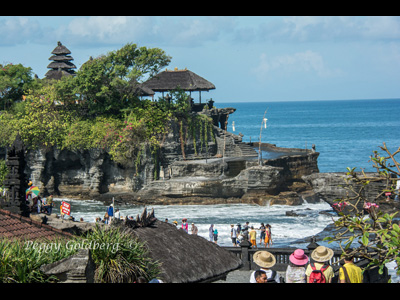 Tanah Lot Temple By The Sea Tanah Lot Temple By The Sea
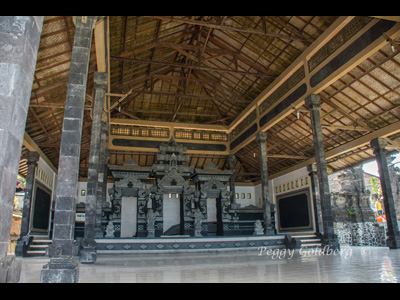 Tanalot Temple Tanalot Temple
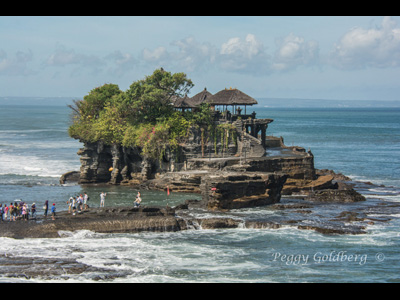 Temple By The Sea Temple By The Sea
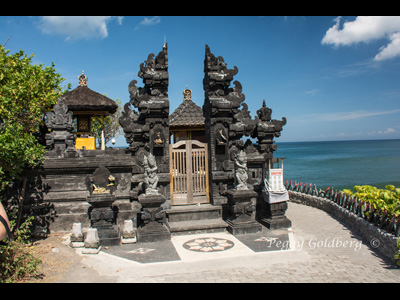 Smaller Temple Smaller Temple
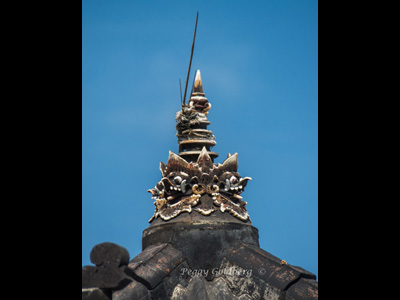 Roof Carvings Roof Carvings
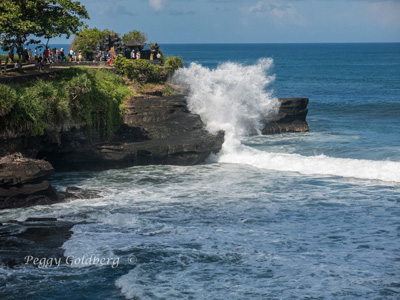 Waves Over Cliff Waves Over Cliff
 Priests Priests
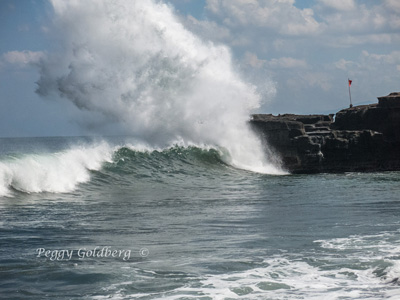 Big Wave Big Wave
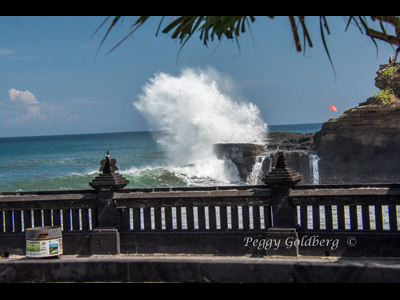 Big Wave On Cliff Big Wave On Cliff
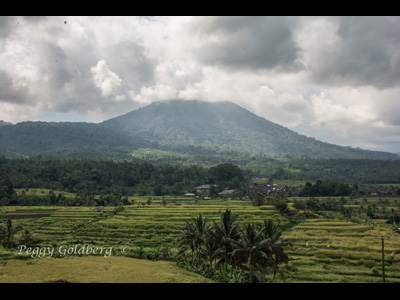 Volcano Volcano
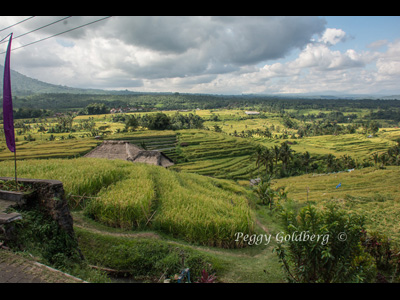 Country View Country View
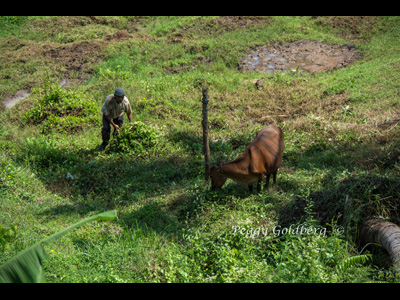 Cow And Farmer Cow And Farmer
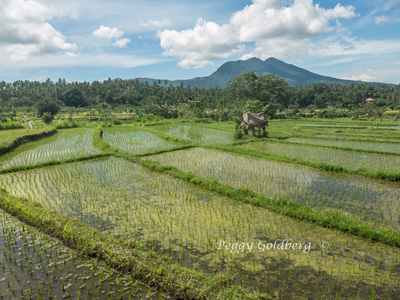 Mountain Rice Field Flooded Mountain Rice Field Flooded
 RiceTerrace RiceTerrace
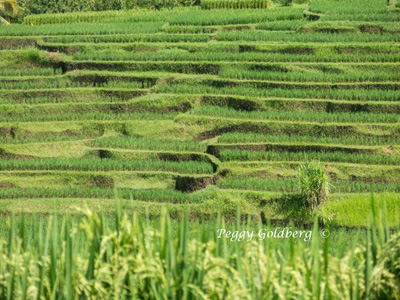 RiceTerrace RiceTerrace
 Rice Terrace And Mountain Rice Terrace And Mountain
 Lake Bratan Temple Lake Bratan Temple
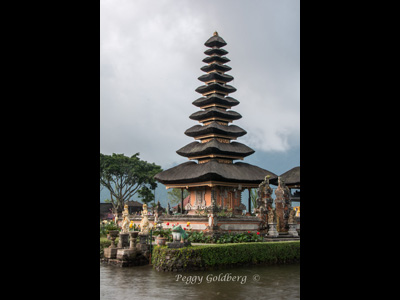 Lake Bratan Temple Lake Bratan Temple
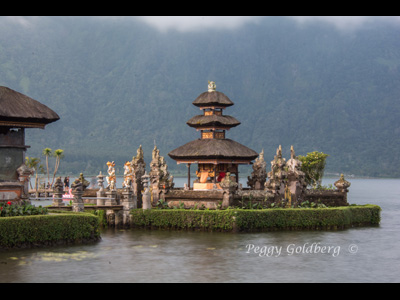 Lake Bratan Temple Lake Bratan Temple
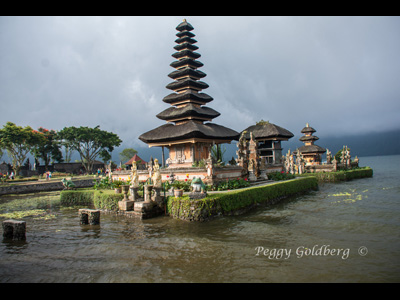 Lake Bratan Temple In Sun Lake Bratan Temple In Sun
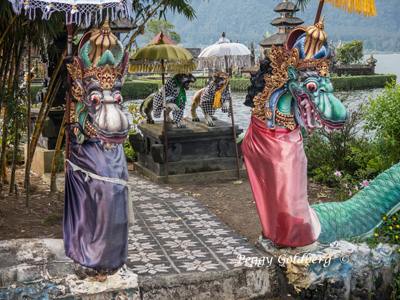 Bratan Dragons Bratan Dragons
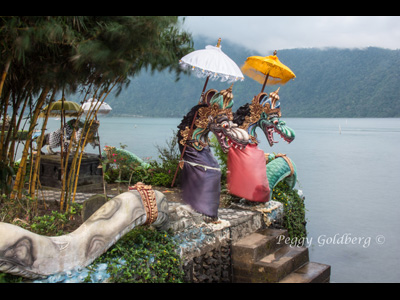 Bratan Dragons Bratan Dragons
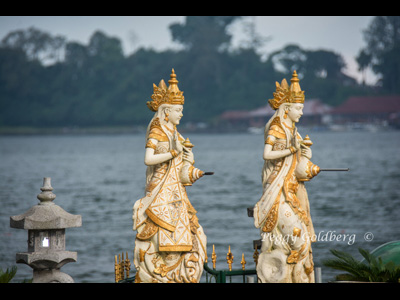 Women Figures Women Figures
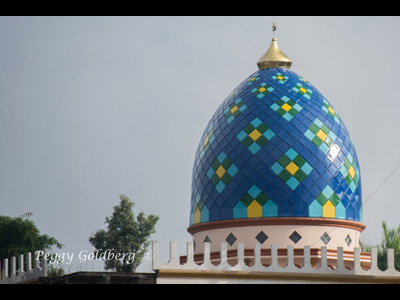 Mosque Roof Mosque Roof
 Tanah Lot Temple By The Sea Tanah Lot Temple By The Sea
Tour Day 2 was the Rice Fields and Temples. Driving to the south, west of Kuta to the Temple of Tanah Lot on the ocean. This was a truly magnificent sight, but closer to the tourist areas of hotels and casinos, it was crowded with tourists. Huge waves crashed over the cliffs and temples. The main temple was sited on an outcropping of rock high above the ocean. This is a must see.
We then drove north to the western upland of Mt Batukaru, famed for its magnificent landscapes and terraces, taking in the whole of Southern Bali. This is a UNESCO World Heritage Site.
From there we went to the Ulun Danu Bratan, a water temple built in 1633 on Lake Bratan. It is one of Bali's directional temples protecting Bali from evil spirits from the northwest. It was a stunning sight with the temple over the water, and the sun shining through the clouds on the ornate architecture and statuary.
There were many local markets we could have wandered through, but we are not shoppers.
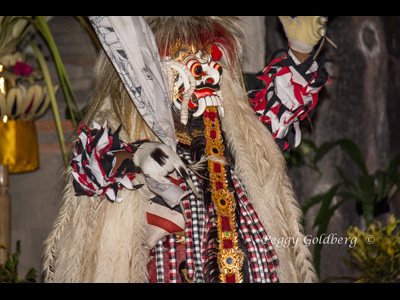 Barong Actor Barong Actor
 Barong Dragon Barong Dragon
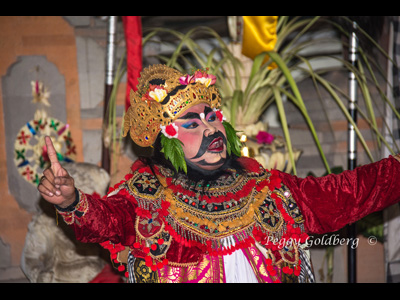 Barong Player CloseUp Barong Player CloseUp
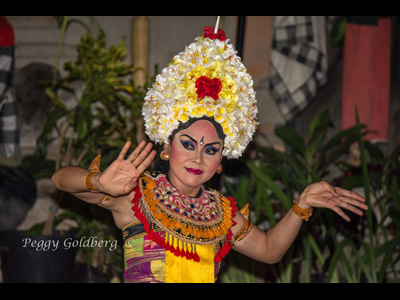 Dancer Closeup Dancer Closeup
 Dancers Dancers
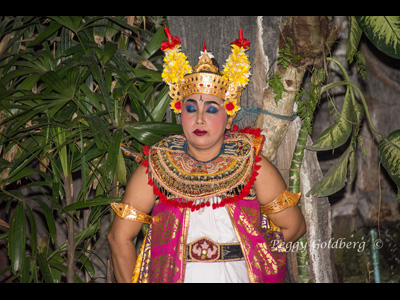 Female Actor Female Actor
 Gamelan Orchestra Gamelan Orchestra
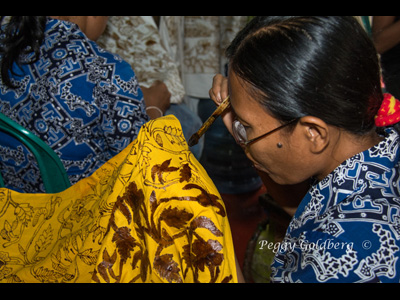 Batik Lady Gold Batik Lady Gold
 Mt Kintamani Mt Kintamani
 Lake Batur Lake Batur
 Volcano Volcano
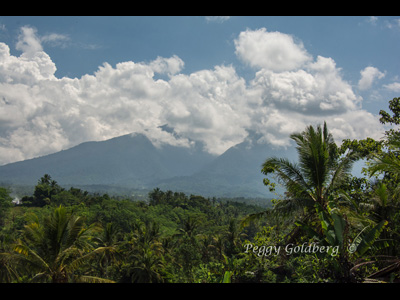 Volcano And Clouds Volcano And Clouds
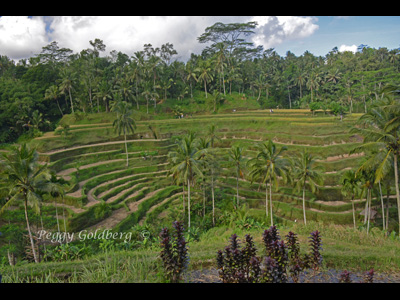 Village of Tegalalang - Rice Terrace Site Village of Tegalalang - Rice Terrace Site
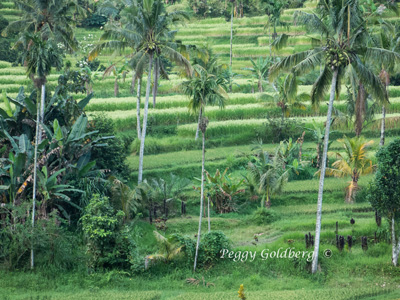 Rice Terraces Rice Terraces
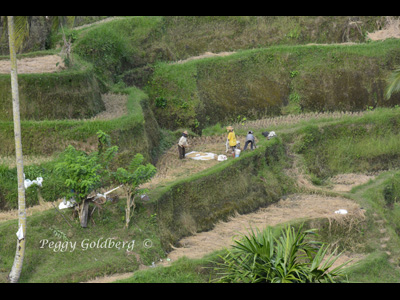 Rice Terrace Tour Rice Terrace Tour
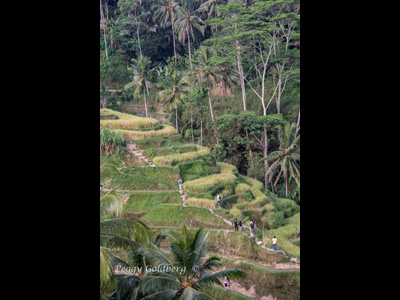 Rice Terrace Tour Rice Terrace Tour
 Rice Terrace Village of Tegalalang Rice Terrace Village of Tegalalang
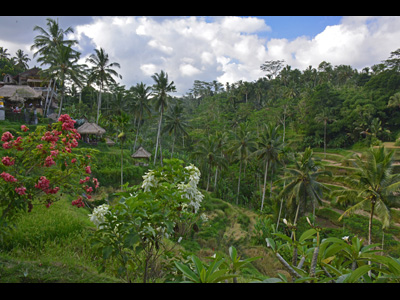 Rice Terrace Site Flowers Rice Terrace Site Flowers
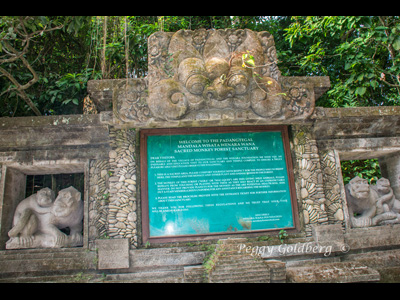 Monkey Forest Sign Monkey Forest Sign
 Mom And Baby Mom And Baby
 Monkey Play Monkey Play
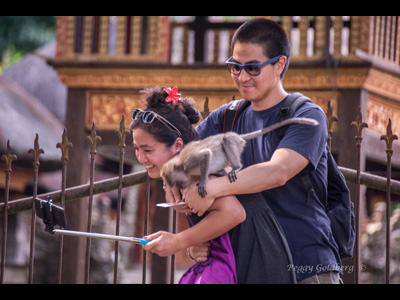 Monkey Selfie Monkey Selfie
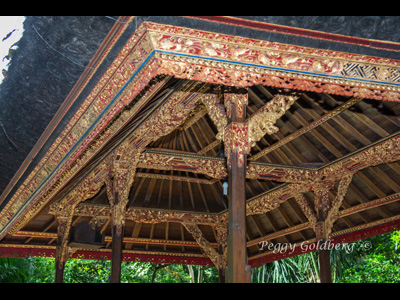 Temple Roof Detail Temple Roof Detail
 Monkey Temple Monkey Temple
 Temple Tower Temple Tower
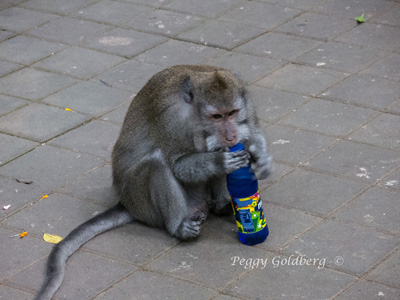 Monkey With Bottle Monkey With Bottle
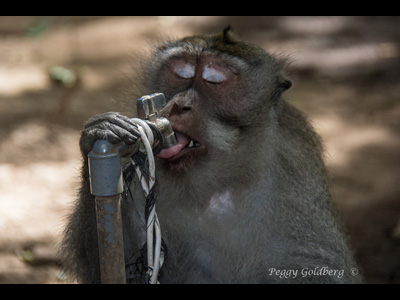 Now That Is A Vintage Year Now That Is A Vintage Year
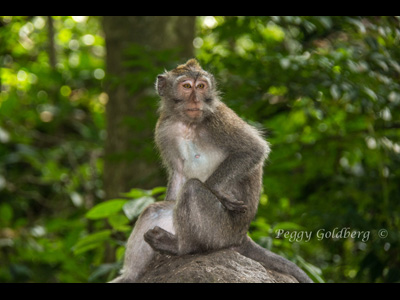 Rhesus Macaque Pose Rhesus Macaque Pose
 Barong Dancer Closeup Barong Dancer Closeup
Tour Day 3 was devoted to cultural Barong dances, the batik factory and Volcanoes. The Barong dance depicts the half dog, half lion creature, Lord of the Forest and protector of Balinese villages. It is a play featuring Gamelan musicians and Balinese dance, depicting the eternal struggle between good and evil. The costumes and makeup were quite elaborate.
From there we went to a Batik factory, where we watched as artisans made the double sided cloth designs, applying wax, changing colors, washing the cloth in hot water. All designs were done by hand.
If there had been time, there were wood carvers, stone carvers, and silversmiths to visit.
We then drove up to Mt Batur, a volcano with a lake in the caldera. It is a breathtaking view, where you can see the lava flows from the eruption in 1994. Eating a Balinese buffet on the open air cliff restaurant gave us plenty of time to enjoy the sights.
From there, we drove down to the Village of Tegalalang, with its beautiful rice terrace views.
We would leave at 8 am and get back to the Villa at 6pm, covering a lot of ground each day.
Tour Day 4 , our last day, we were on our own, so we decided to take the shuttle into Ubud. We walked about and visited the Sacred Monkey Forest Sanctuary. Over 500 Balinese Macaques roam among the temples, built in the mid 11th century. This is a holy place, and the monkeys are revered. The monkeys can be aggressive though, stealing your water bottle, jewelry, glasses, cameras if you let them. People that fed them and tried to interact had the most problems. By observing, and avoiding direct eye contact, we were able to get close enough for some interesting photos.
The next day, we were driven to the airport to catch a charter plane for the second leg of our adventure. Diving adventure at Wakatobi awaits us.
In the short time we had in Bali, though we did get to see a variety of sites, there is still a lot to see and do. The Balinese society is complicated, their daily lives intertwined with religion and many rules of conduct. We did study what we could and could not do. We highly recommend a guide to make the process much easier. In addition, you learn so much more than being on your own.
Bali is a unique, beautiful and exotic place, where the traffic may be insane but the peacefulness of the people and country leaves you with a calm spirit and a thoughtful experience.
|
[Home] [ Articles] [Classes] [Commercial] [Photo Tips] [Photo Gallery]
Please contact our Webmaster with questions or comments.
©
Copyright
2000-2021 Golden Images, Inc. All rights
reserved.
|



